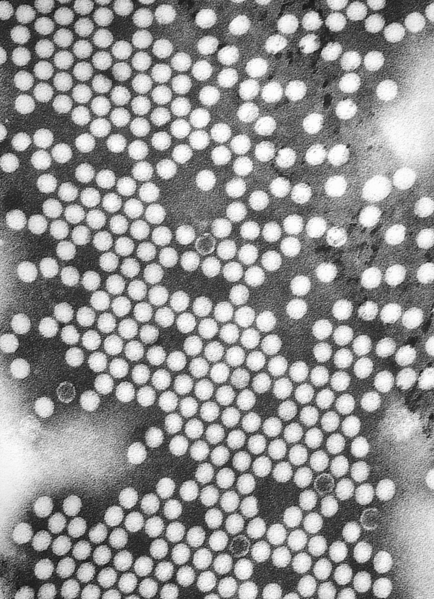Polio causes
|
Polio Microchapters |
|
Causes |
|---|
|
Diagnosis |
|
Treatment |
|
Case Studies |
|
Polio causes On the Web |
|
American Roentgen Ray Society Images of Polio causes |
Editor-In-Chief: C. Michael Gibson, M.S., M.D. [1]
Overview
Polio is a highly infectious disease caused by Poliovirus that invades the nervous system. Poliovirus are small (27–30 nm), nonenveloped viruses with capsids enclosing a single-stranded, positive-sense RNA genome about 7,500 nucleotides long. Person-to-person spread of poliovirus via the fecal-oral route is the most important route of transmission, although the oral-oral route may account for some cases.
Taxonomy
Viruses; dsDNA viruses, no RNA stage; Polyomaviridae[1]
Biology
 |
Poliovirus is a member of the enterovirus subgroup, family Picornaviridae. Enteroviruses are transient inhabitants of the gastrointestinal tract, and are stable at acid pH. Picornaviruses are small, ether-insensitive viruses with an RNA genome.
There are three poliovirus serotypes (P1, P2, and P3). There is minimal heterotypic immunity between the three serotypes. That is, immunity to one serotype does not produce significant immunity to the other serotypes. The poliovirus is rapidly inactivated by heat, formaldehyde, chlorine, and ultraviolet light.
Poliomyelitis is caused by infection with a member of the genus enterovirus known as poliovirus (PV). This group of RNA viruses prefers to inhabit the gastrointestinal tract. PV infects and causes disease in humans alone. Its structure is very simple, composed of a single (+) sense RNA genome enclosed in a protein shell called a capsid. In addition to protecting the virus’s genetic material, the capsid proteins enable poliovirus to infect certain types of cells. Three serotypes of poliovirus have been identified—poliovirus type 1 (PV1), type 2 (PV2), and type 3 (PV3)—each with a slightly different capsid protein.[3] All three are extremely virulent and produce the same disease symptoms. PV1 is the most commonly encountered form, and the one most closely associated with paralysis.
Individuals who are exposed to the virus, either through infection or by immunization with polio vaccine, develop immunity. In immune individuals, IgA antibodies against poliovirus are present in the tonsils and gastrointestinal tract and are able to block virus replication; IgG and IgM antibodies against PV can prevent the spread of the virus to motor neurons of the central nervous system. Infection or vaccination with one serotype of poliovirus does not provide immunity against the other serotypes, and full immunity requires exposure to each serotype.
Natural Reservoir
Humans are the only known reservoir of poliovirus, which is transmitted most frequently by persons with inapparent infections. There is no asymptomatic carrier state except in immune deficient persons.
References
- ↑ "Polyomavirus".
- ↑ "http://phil.cdc.gov/phil/details.asp". External link in
|title=(help) - ↑ Katz, Samuel L.; Gershon, Anne A.; Krugman, Saul; Hotez, Peter J. (2004). Krugman's infectious diseases of children. St. Louis: Mosby. pp. 81–97. ISBN 0-323-01756-8.